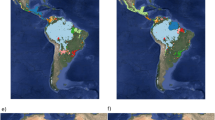Abstract:
We study finite-size effects in the self-organized critical forest-fire model by numerically evaluating the tree density and the fire size distribution. The results show that this model does not display the finite-size scaling seen in conventional critical systems. Rather, the system is composed of relatively homogeneous patches of different tree densities, leading to two qualitatively different types of fires: those that span an entire patch and those that do not. As the system size becomes smaller, the system contains less patches, and finally becomes homogeneous, with large density fluctuations in time.
Similar content being viewed by others
Author information
Authors and Affiliations
Additional information
Received 24 April 1999 and Received in final form 26 October 1999
Rights and permissions
About this article
Cite this article
Schenk, K., Drossel, B., Clar, S. et al. Finite-size effects in the self-organized critical forest-fire model. Eur. Phys. J. B 15, 177–185 (2000). https://doi.org/10.1007/s100510051113
Issue Date:
DOI: https://doi.org/10.1007/s100510051113




